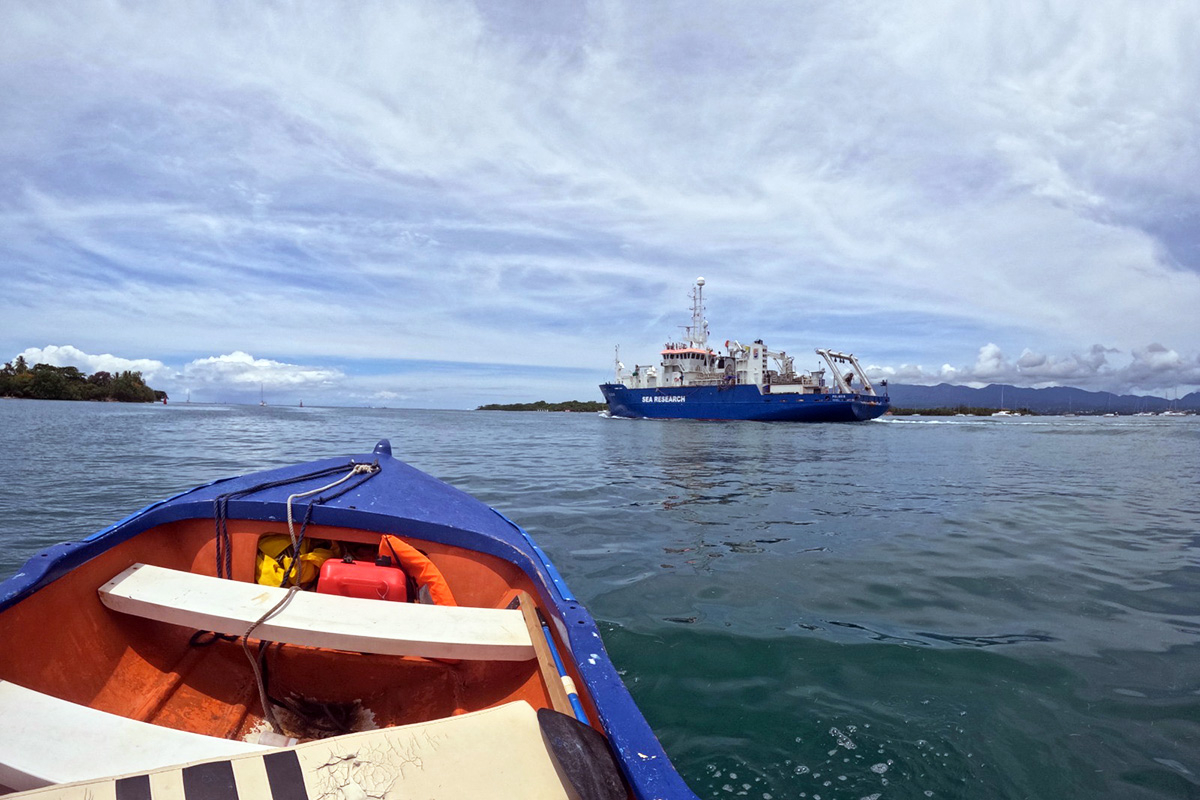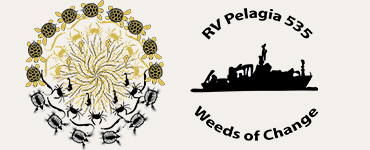12 July 2024
Golden Waves Departing
Written by Linda Amaral-Zettler, Chief Scientist 64PE535
Tomorrow, we end our 4-week voyage through the GASB. It has been a remarkable journey on so many levels – scientific, cultural, social, collaborative, and even culinary (thank you, Enno)! As Chief Scientist onboard, there is great anticipation before every voyage: Will the seas and the weather be kind? Will the experiments work? Will the equipment malfunction? Will we gather enough samples? Will we accomplish most of what we set out to do? In this case – we have been so fortunate to be able to successfully study Sargassum seaweed in its native habitat – the open ocean – with a battery of different approaches and to a much larger extent than could be accomplished by a single group alone. From keeping a safe distance from nascent tropical cyclone Beryl to recovering our Sargassum Trap with dead reckoning (thank you, Captain Lucassen!) and an eagle-eye spotter (thank-you, Juliane) after their beacons failed: we have been very lucky on multiple counts.
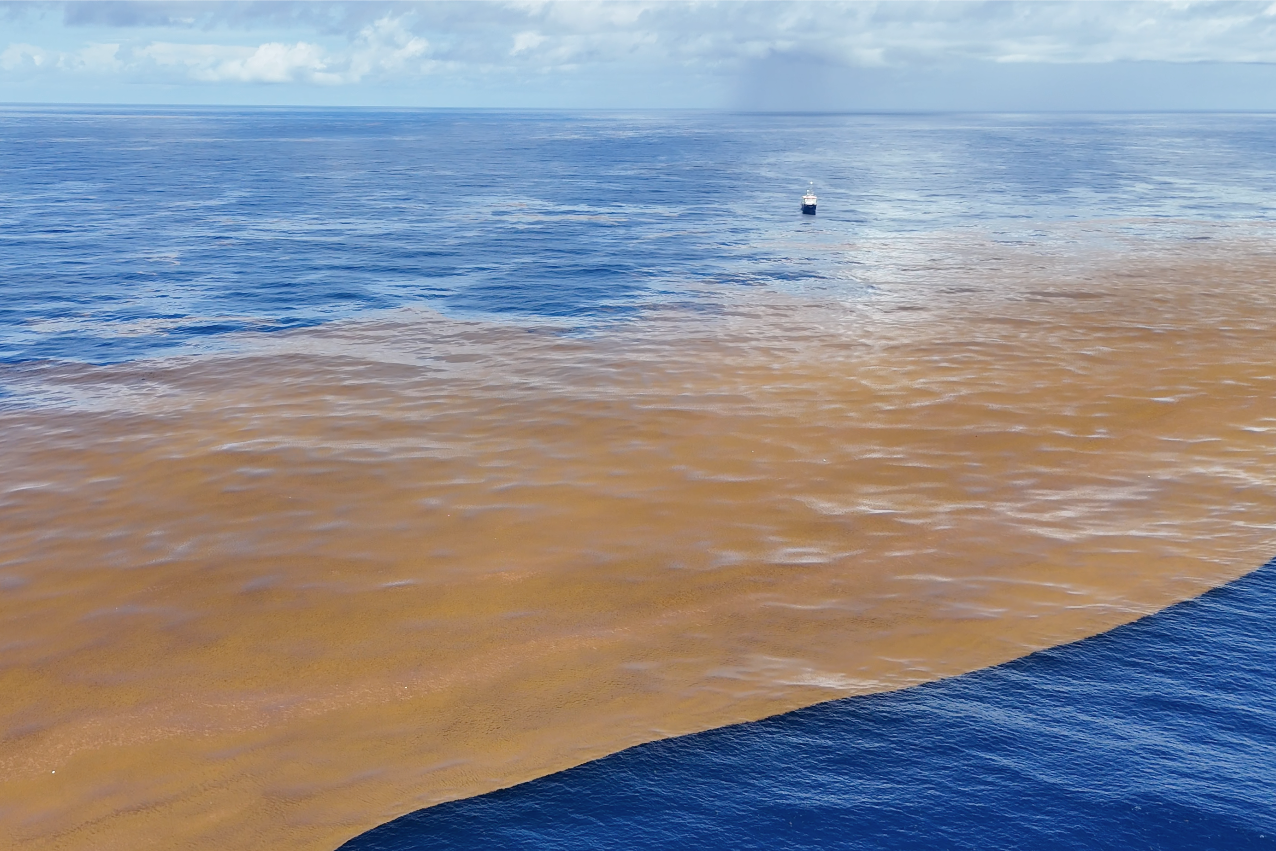
While we celebrate the success of a productive expedition – the mood is also bittersweet to realize the magnitude of the problem we are studying, heightened by the sheer size of the Sargassum patches we encountered and the accompanying inability to capture their extent. Perhaps we’ve generated more questions than answers: Where will these masses end their journey? Will they sink to the seafloor abyss or continue on to strand on coastlines, wreaking havoc upon arrival?
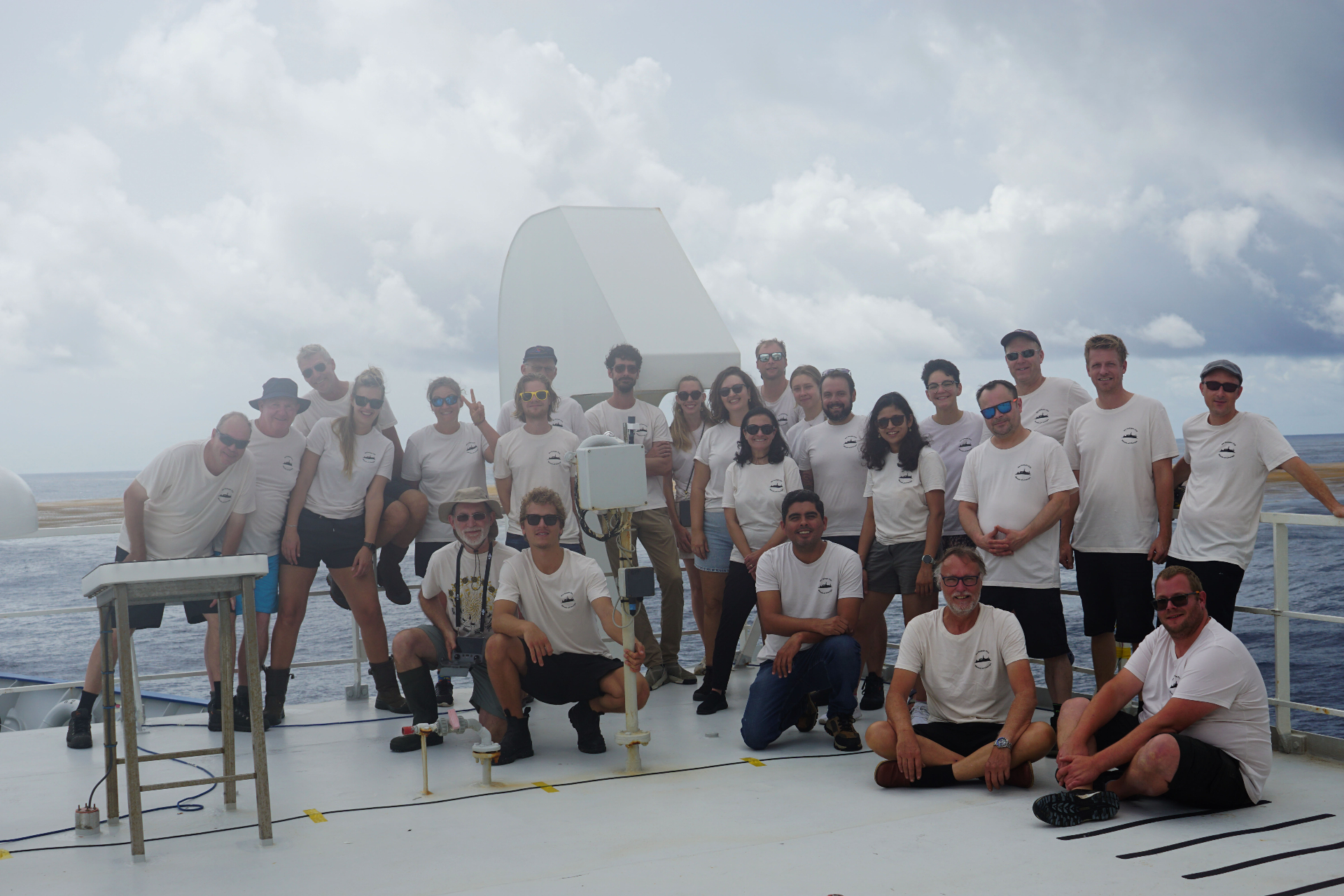
As we part ways – we’ll continue to discuss and meet through mostly virtual means. For many of us having never met or sailed together, it has been a true bonding experience and undoubtably one that will linger long after our return home.
Hartelijk bedankt en een goede reis allemaal: Warm thanks and safe journeys everyone!
11 July 2024
Plastic in the great Atlantic Sargassum Belt (GASB)
Written by Erik Zettler, Amaral-Zettler Research Group, NIOZ
The focus of this research expedition is Sargassum, but another widespread and increasing substance floating in surface seawaters is plastic pollution. As part of the NWO project “Nanoplastics: Origin, Structure, and Fate” I am collecting samples for nanoplastic analysis in the laboratory of Prof. Dr. Weckhuysen at Univ. of Utrecht, as well samples for the Amaral-Zettler group at NIOZ studying interactions between (nano)plastic and the Plastisphere, micro-organisms associated with plastic. The GASB is a region of ocean water divergence, so waters are moving away from this area and we don’t see the plastic accumulations in the better-known convergence zones or “garbage patches”. I have been checking every one of the Manta net samples used to collect Sargassum for pieces of plastic, but we have seen remarkably little. However, we do see numerous pieces of macroplastic in the Sargassum mats we are studying, from the Pelagia deck, when working in the small boat, and in drone overflights used to visualize the Sargassum patch size and shape.
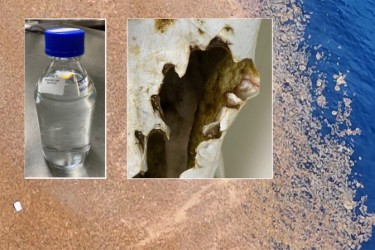
It seems like the Sargassum acts as a sponge to entangle and retain floating plastic. We have collected a number of these pieces of macroplastic, and some show bite marks from fish, such as on the bottle to the right. Many fish and other organisms are known to ingest plastic, perhaps because the microbes such as the reddish algae on this bottle make it smell and taste like food. This kind of fragmentation of the microplastic into ever smaller pieces due to interactions with animals and weathering eventually results in particles so tiny that they are invisible. At some point they reach a size small enough to enter the cells of microbes (and animals like humans), but the impact of these “nanoplastic” particles on living organisms is still mostly unknown.
Their small size makes finding, identifying, and counting the nanoplastic in seawater very challenging, and that is one of the goals of the Nanoplastics: Origin, Structure, and Fate project: To understand how they are formed, what shape / size / composition they have, where in the ocean they occur, how they interact with marine organisms, and what eventually happens to them. So, in addition to the plastic samples like the plastic bottle from the mat, we are also collecting bottles of seawater along the cruise track as shown to the left; they look like pure, clean, seawater, but based on research by other scientists including our colleague Helge Niemann at NIOZ, we suspect they will contain invisible nanoplastics, even in this remote area of the ocean.
10 July 2024
Chasing Sargassum Through the Great Atlantic Sargassum Belt
Written by Lizzie Gower, WHOI-MIT student
It’s hard to believe there are only three days left on the Weeds of Change (WoC) Cruise. I’ve gotten to see so many amazing things; schools of mahi-mahi and shoals of squid hunting for food in the ship’s light at night, a leatherback sea turtle flapping his fins around to say hi to the Pelagia, the glow of the milky way and hundreds of stars on a clear night, some amazing sunsets over the water, and of course Sargassum patches!
While we traverse the Great Atlantic Sargassum Belt, large patches are not as abundant as the name alludes, and when such patches are found it is crucial to gain as much data on them as possible. That’s where the Chase Drifters come in. They are designed to entangle with Sargassum and stay with the patch as it travels to wherever the ocean takes it, collecting data on the density of the Sargassum and the carbon dioxide and oxygen concentrations in the water of the patch. Although they are named after the engineer who designed them, Chase Pixa, I like to think of them as chasing the Sargassum around the ocean. The Weeds of Change project has taught me so much about Sargassum. Using this new knowledge, when I’m back on shore I’ll expand upon the drifters’ capabilities in a meaningful way, hopefully all the while reminiscing on the fun I’ve had on this cruise!
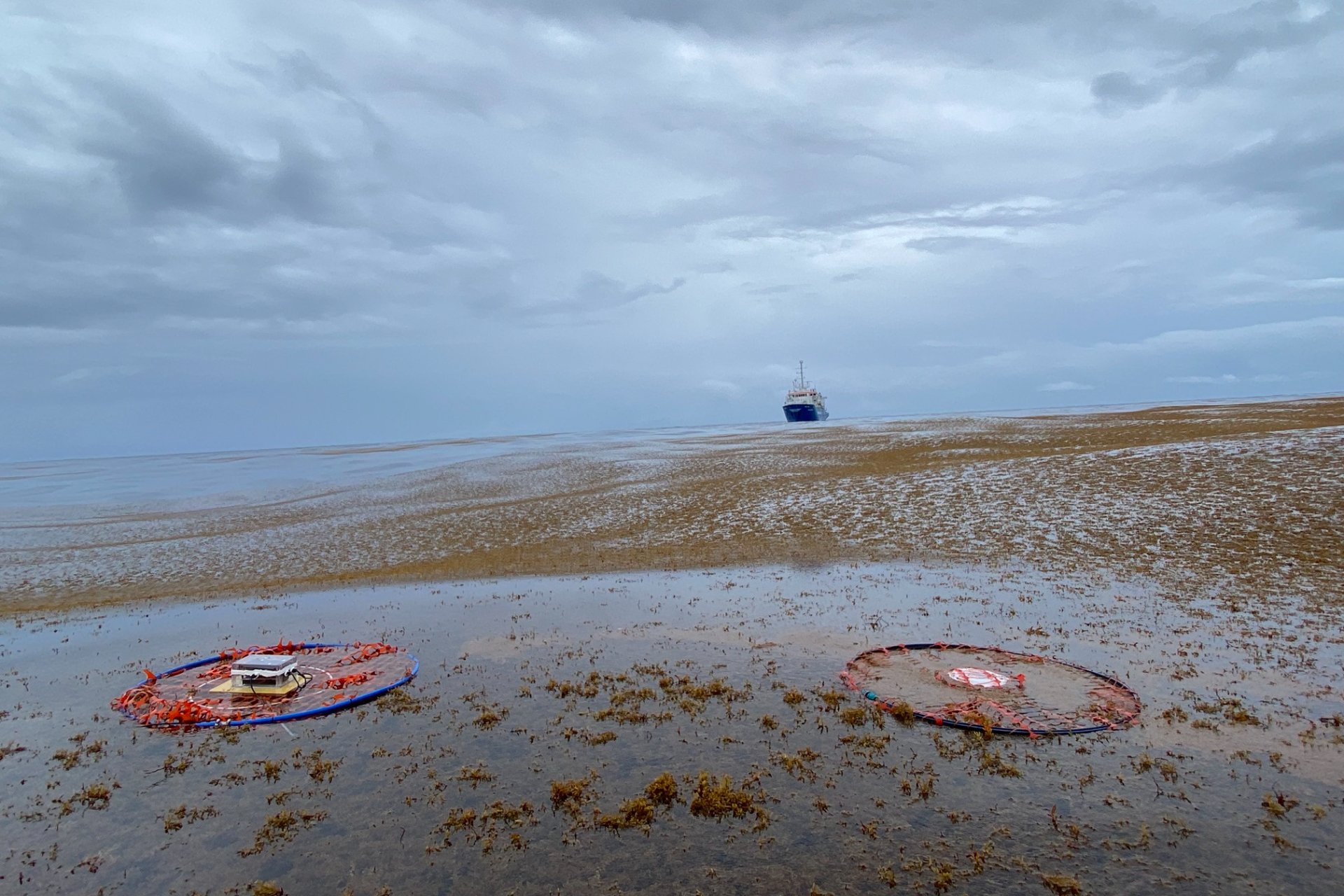
Before the WoC project, I knew nothing about Sargassum and very little about biology. I am an Electrical Engineering student enrolled in the WHOI-MIT (Woods Hole Oceanographic Institution – Massachusetts Institute of Technology) Joint PhD Program, so studying seaweed is new to me. While I was nervous about coming on to a ship full of biologists and seaweed nerds, all of my worries melted away immediately. Not only has everyone helped me learn, but I have had so much fun with the scientists and the crew! Adventures on the small boat with Jacco and Robert, learning a Bollywood dance from Darshika, practicing my French with Deb and Marine, watching Fargo with Fred and Ravi, learning about everyone else’s cultures, and just goofing around with people has all made for a truly memorable experience.
My PhD advisor, Dr. Anna Michel and I are extremely lucky to have this opportunity for me to deploy the drifters with the Weeds of Change group across the Atlantic Ocean. I’d like to especially thank Prof. Linda Amaral-Zettler and Dr. Erik Zettler for the opportunity to be a part of this project. It is something I will forever be grateful for and never forget!
9 July 2024
Heavy metals in Floating Algae!
Written by Débora Héroin, University of Bordeaux
Hello, I'm Deb. Normally, I work in an Aquatic Ecotoxicology laboratory at the University of Bordeaux in France, but at this moment I am part of the French team on board the Dutch Research Vessel (RV) Pelagia for the International ANR Weeds of Change Sargassum project. Ecotoxicology involves understanding the link between the presence and effects of contaminants, by studying in particular the uptake, bioaccumulation and biotransformation capacities of these compounds, as well as their impacts on organisms.
In open ocean waters, we love to see the Sargassum! They float on the surface, bring beautiful golden colors to the sea and provide an incredible habitat for many animals. There is plenty of life below a patch of Sargassum as it provides food, shade and shelter for fish, shrimp, crabs and turtles.
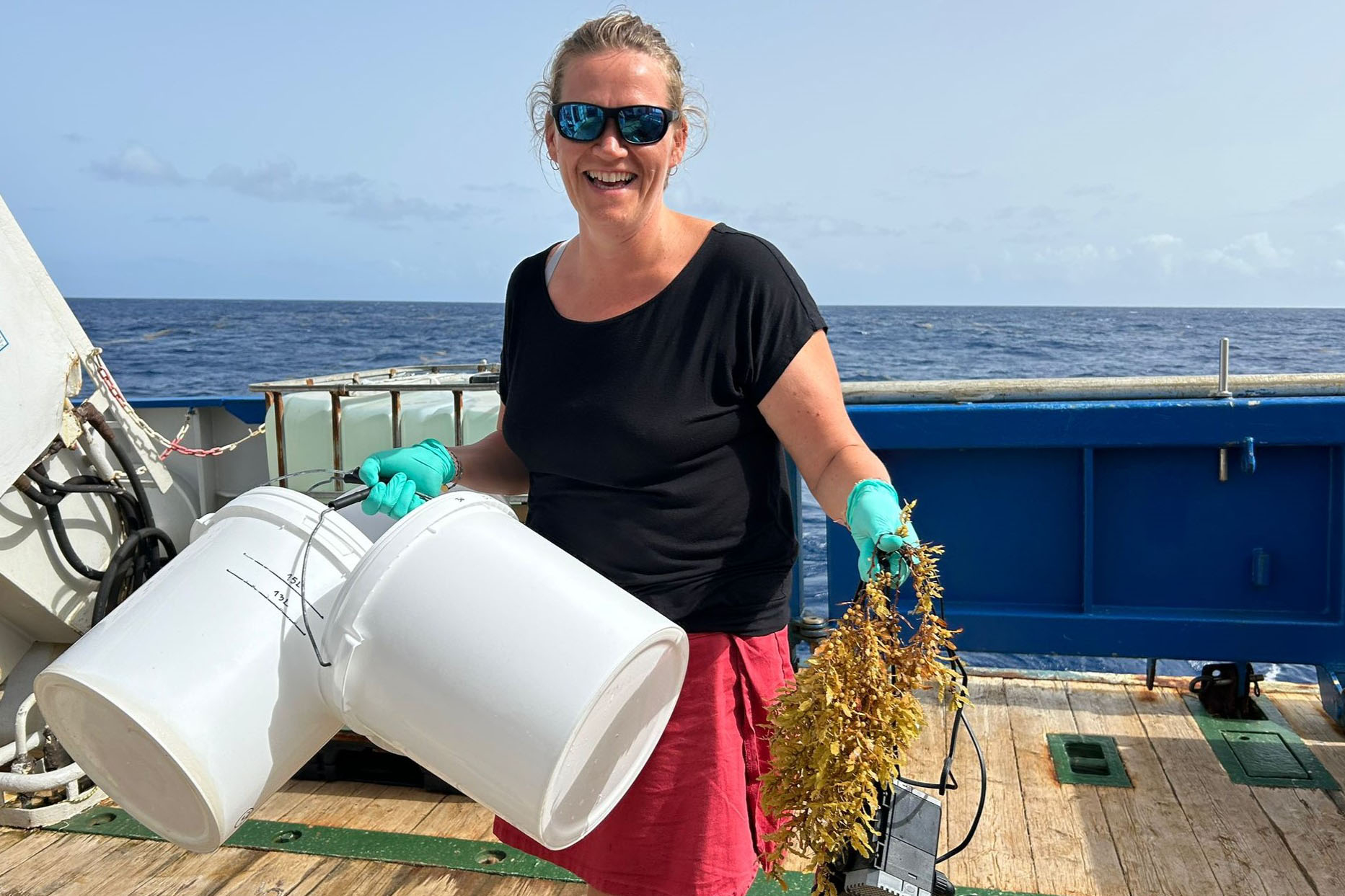
But, excessive amounts of Sargassum on coasts cause a lot of problems, we hate to see them there. In fact, large amounts of Sargassum seaweed in areas of the Caribbean have been creating many environmental, physiological, ecological and economic impacts. Decomposition of organic matter produces large quantities of toxic gases (hydrogen sulfide (H2S) and ammonia (NH3)) which can be toxic in the event of high exposure to humans, smells very bad, attracts insects, and causes many ecological problems (smothering turtle nesting sites, sea turtle mortality, fish kills…) and economic problems. Morever in its life cycle, Sargassum species accumulate different metals, some of which hinder reclamation projects.
Our growth experiment objectives include : i) How are metals bioaccumulated in Sargassum?; ii) In what quantities and in what forms are these metals transported by different bodies of water ?; and, iii) How do these metals influence the growth of these algae ?
I am on board this expedition as a technician to carry out our experiments on board, as well as to help the team on a daily basis. I designed an experimental system for exposing Sargassum to metals in the laboratory which was tested in Guadeloupe as part of Marine Guilbaud’s master's research. In this transatlantic voyage, we are setting up similar experiments on board the vessel, so as to carry out 4 consecutive experiments along the transect from the Antilles to Cape Verde. This brown, floating algae is very resistant and long-lived in the natural environment but proves to be very difficult to maintain in a closed environment. It is precious! This difficulty in being maintained in a captive environment requires special attention and precautions every time.
In the long term we hope to offer solutions for the utilization of these stranded Sargassum tides (fertilizer, food, fuel, pharmaceutical equipment...) that are currently very challenging given their high levels of metal contamination.
4 July
Seaweeds: the magic of the moment
Written by dr. Juliane Bernardi Vasconcelos, Scientist at Universidade Federal de Pernambuco, Brazil
Hello, my name is Juliane. I’m a Brazilian oceanographer abord the RV Pelagia for the Weeds of Change (WoC) research expedition. It has been 22 days since we left the beautiful Caribbean Island of Guadeloupe. Since then, we've been busy! We've cleaned buckets, secured buckets, filled buckets, deployed high-tech equipment, carried heavy things around, climbed a lot of steps, bumped against some, spilled hot soup during lunch, slept like a baby to the ocean waves, watched the stars, and laughed (a lot) with each other.
I've been working with seaweeds since I was an undergrad student, and for the first time, I’m not collecting them. Seaweeds are the macroscopic algae you encounter on the beaches attached to rocks, mangrove trees and tropical reefs. However, the pelagic Sargassum is unique because it floats, so it spreads through the Atlantic carried by the currents. We have seen this every day from our cabin’s portholes.
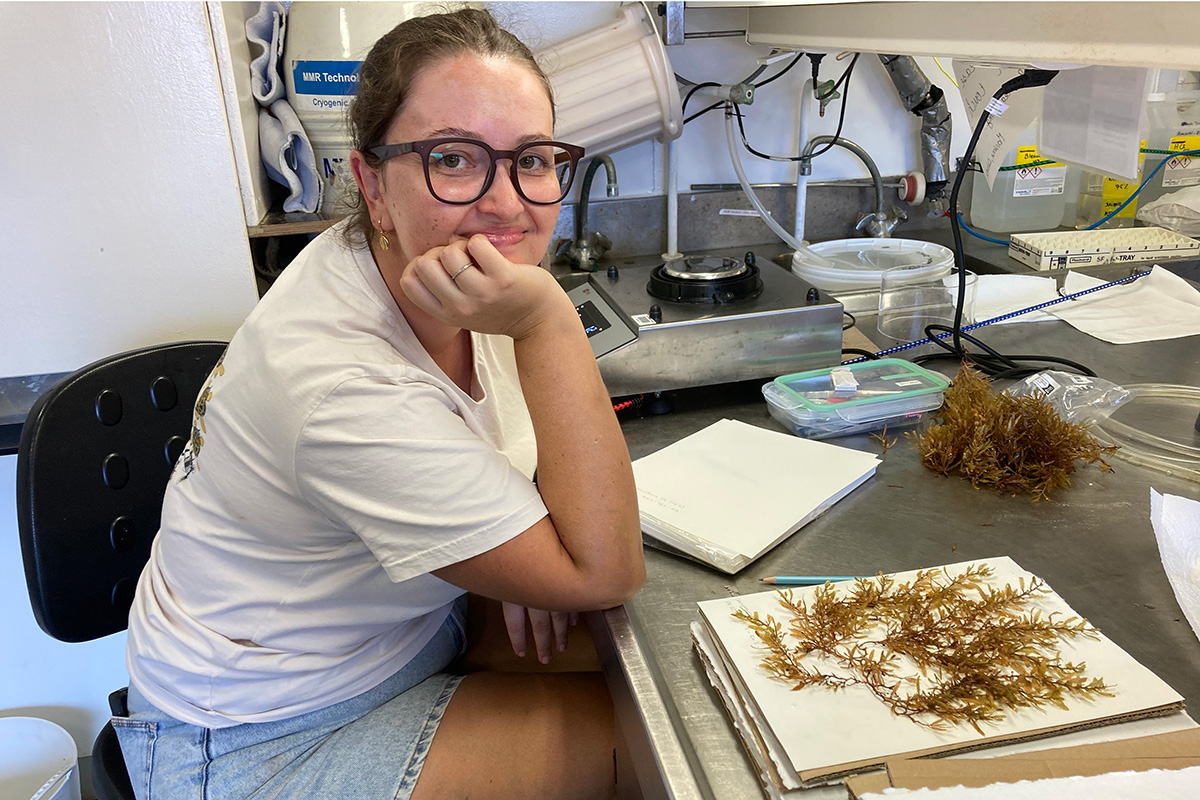
My main job on the cruise is to sample the diverse fauna that lives associated with the Sargassum, which includes some cranky crabs, jumpy shrimps, beautiful blue copepods, amphipods, anemones, flying fish and some tiny pelagic snails. These animals will be latter analyzed by my colleague Dr. Jesser Fidelis de Souza Filho, in collaboration with the Brazilian foundation FACEPE from Pernambuco and the WoC consortium. On land, I am also the responsible for the coastal experiments with Sargassum in Brazil.
During our cruise, we have seen Sargassum bloom and prosper right in the middle of the Atlantic. It is incredible how a seaweed may flourish in the vast expanse of the ocean and manage to sustain an entire ecosystem. At the same time, we must acknowledge the concerning reality that some of this biomass will inevitably make its way to the coast, potentially affecting numerous communities.
As an oceanographer who studies seaweeds, this expedition has been the most enriching experience of my career. I am grateful to our leader, Prof. Dr. Linda Amaral-Zettler, and Dr. Erik Zettler, from NIOZ, for the opportunity. A great scientist once told me “Where you have seaweeds, you have friends.” And that’s how it feels.
2 July
Going Deep: Tracking Sargassum from the surface to the ocean floor
Written by Julia Schnetzer, postdoc at the Alfred-Wegener Institute
The ocean has taken up and stored about 30% of anthropogenically released CO2 from the atmosphere. This happens in two major ways: via the physical carbon pump where CO2 is absorbed by ocean water and gets down-welled by currents into the deep ocean or via the biological carbon pump. Here algae and photosynthetic microbes take up CO2 by photosynthesis and integrate the carbon into their biomass, hence it is stored there temporarily. This carbon travels through the food web. The microbes or algae get eaten by zooplankton, which get eaten by fish, which get eaten by bigger fish and so on... During its food web journey, part of the carbon will be excreted by animals and sink slowly down to the deep waters. If you’ve ever watched videos from the deep sea, you might have noticed the white particles floating by, almost looking like a snow storm, hence the term 'marine snow'. A very poetic name for 'poo'. Now you know.
If the plankton and fish don’t get eaten (or end up on Jacco‘s fishing rod) they die and sink to the deep sea, taking the carbon with them. Why is the sinking such an important part, you may ask? The deep ocean is quite an extreme environment. The deeper it goes, the higher the pressure and the lower the temperature. In this cold darkness, everything slows down, especially the metabolism of cells. Which means degradation processes take much longer than they would on the surface layers. So the carbon, locked up in the marine snow and dead material sinking down, is released much slower, and it will take hundreds of years until the deep water containing this carbon will be upwelled and reach the atmosphere again. Some of the carbon may even get covered with sediment and become a permanent part of the ocean floor. The deeper it falls, the longer it will be stored in the deep.
Scientists have studied these 'ocean pumps' for decades, but now there is a new player in the game: Sargassum. To be fair, the player is not new, but the field it is playing in, is. By expanding its habitat from the Sargasso Sea to the Great Atlantic Sargassum Belt (GASB) there is much more Sargassum biomass floating around. The questions we are interested in now are, what happens to all that Sargassum and what is its role in the biological carbon pump? How much Sargassum is out there? How much carbon does it take up? We know a lot does wash up on the beaches of the Caribbean, but does it also end up in the deep sea? And if so, does it get eaten, degraded or buried? How fast does it sink? So many questions, so many answers may lie down there in the deep dark ocean. This cruise is already shining some light into this darkness.
We use 13C, a marker to study the algal carbon fixation rate under different environmental conditions. We lower camera systems down to over 4,000 meters to explore the hidden ocean floor and its mysterious creatures, keeping an eye out for sunken Sargassum. We release special Sargassum traps into the water designed to collect sinking Sargassum at 100-meters depth. With all these different approaches and methods, we hope we will get a better understanding of the Sargassum carbon cycle. Spoiler alert: We did find it in the deep sea :-) Maybe Sargassum is a bigger carbon sink than previously thought?!
My Professor Mar Fernández-Méndez and I are positive Sargassum has big potential for carbon sequestration and storage and might be a great alley to tackle climate change. We are more than thankful to Chief Scientist Linda Amaral-Zettler and the Weeds of Change Consortium giving us the opportunity to join this cruise.
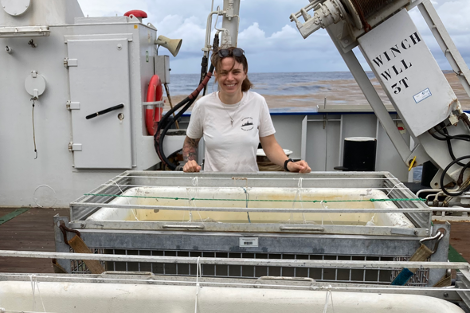
1 July
Understanding the past to explain the present
Written by: Fabio Nauer, NIOZ NWO Weeds of Change Postdoctoral Scientist
It’s July 1th, the 19th day of our Sargassum expedition, and we are heading to our next station in the “Great Atlantic Sargassum Belt”. I am a postdoctoral researcher at NIOZ, working under the guidance of Prof. Dr. Linda Amaral-Zettler, and my role on this expedition encompasses various responsibilities. From studying the physiological responses of Sargassum in our growth experiments to collecting samples from the mats for population genetics analysis and observing morphological variations, the scope of our research is both broad and detailed.
However, one of the most intriguing aspects of my work is investigating whether there have been similar accumulations of this brown alga in Earth's history or if these events are unprecedented in the new millennium. This phase of our work involves the expertise of NIOZ scientists Drs. Nicole Bale and Rick Hennekam. Current records of floating Sargassum amassing on beaches are relatively short, spanning less than two decades. To gain deeper insights, we turn to geological records, which might hold the key to understanding the frequency and causes of these inundations, thereby aiding in predicting future growth dynamics.
As holopelagic open-ocean Sargassum ages, it eventually sinks, leaving remnants on the seabed, buried in sediments. This sedimentary record could serve as an archive of past Sargassum population distributions and their interannual variability. Throughout our cruise, with the invaluable assistance of Leon Wuis, one of our skilled technicians, we are collecting multi-core samples along our route. These samples are then subsampled for vertical profiles through the sediment and processed for genetic and lipid biomarker analyses, providing a window into changes over geological time in Sargassum deposition on the ocean floor.
Employing a comprehensive suite of geo and biomarkers, we aim to build multiple lines of evidence from these sedimentary archives. This approach allows us to reconstruct various environmental parameters, such as sea surface temperature, salinity, and river discharge, at the time of deposition—factors that may have influenced past and present Sargassum accumulations.
By delving into this historical baseline, potentially extending back 100 to 1000 years, we hope to unravel the mysteries surrounding the current versus previous distributions and changes in Sargassum abundance, particularly before the notable onset of modern strandings in 2011. This knowledge is crucial not only for understanding the past but also for anticipating and managing future Sargassum events.
Stay tuned as we continue to uncover the secrets of the Great Atlantic Sargassum Belt, piecing together the intricate puzzle of our planet's dynamic marine ecosystems.
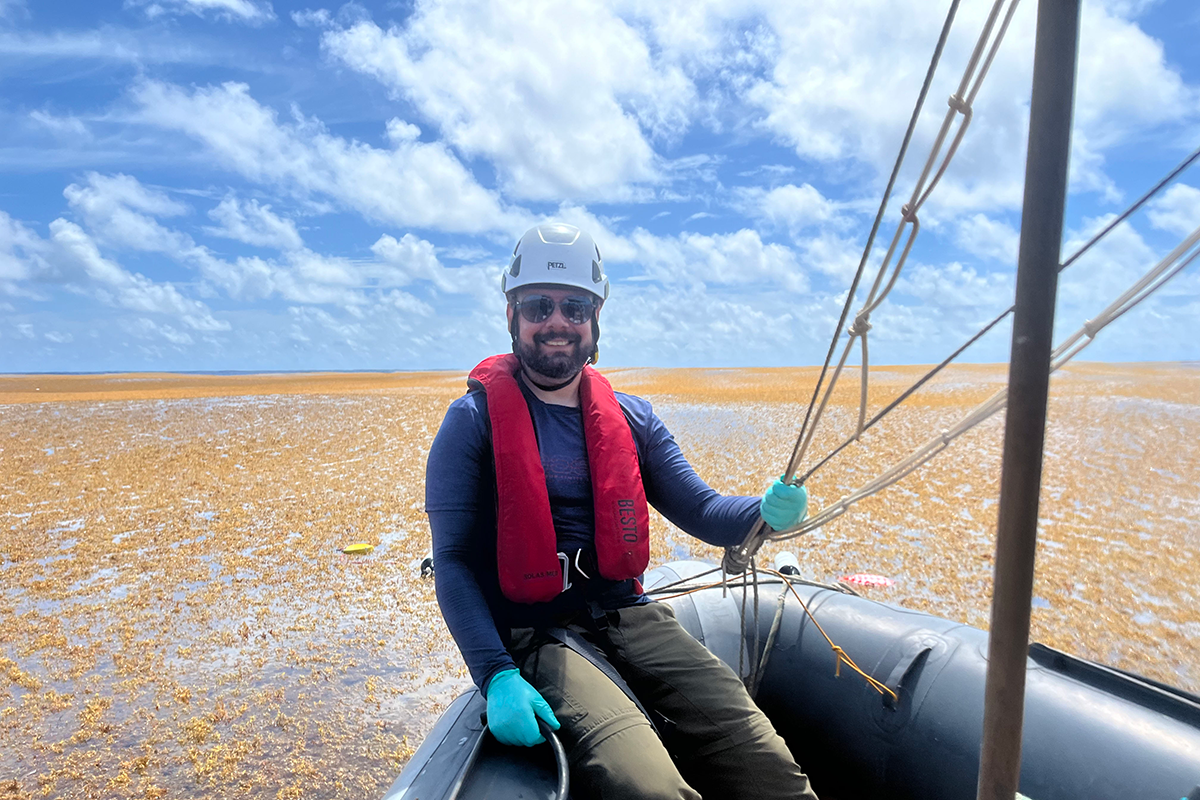
27 June
The Sargassum patch chasers!
Written bij Darshika Manral
It’s day 15 of our voyage (27th June) and we are almost halfway through our trans-Atlantic expedition to find large patches of Sargassum in the Equatorial Atlantic Ocean during their peak accumulation in June-July. Studying these patches is essential to understand their sudden and mysterious expansion in this region since 2011 and to develop better coastal management strategies upon arrival.
As a PhD researcher at Utrecht University, I am supervised by Professors Erik van Sebille (UU) and Linda Amaral-Zettler (NIOZ & UvA) as part of the EU Horizon 2020 project AtlantECO. My research in physical oceanography focuses on how ocean currents establish connectivity between different regions of the ocean. For more than three years, my work has largely been computer-based, simulating virtual particles with ocean data and analyzing the trajectories of plankton, plastic, nutrients, and even turtles. The Weeds of Change project led me to model the transport of Sargassum in the Atlantic Ocean and to work outside my computer screen by joining this cruise.
To better understand Sargassum movement, we are releasing satellite communication-enabled trackers called drifters to monitor the movement of Sargassum patches in real-time. This past week, we placed three drifters on a large Sargassum patch and successfully followed the drifters and the patch for almost two days. You can follow the trajectories of the drifters released so far at this link. These drifters have been named after the endemic and associated species of Sargassum.
Experiencing the open ocean firsthand has been a dream come true and an incredible learning opportunity. I've met amazing people and observed how Sargassum fosters not only multiple marine species in the open ocean but also collaboration among researchers from diverse fields. A big thanks to the RV Pelagia crew, who have been exceptionally supportive and helpful throughout our journey.
Looking forward to deploying the remaining drifters in the Sargassum patches in the coming days!
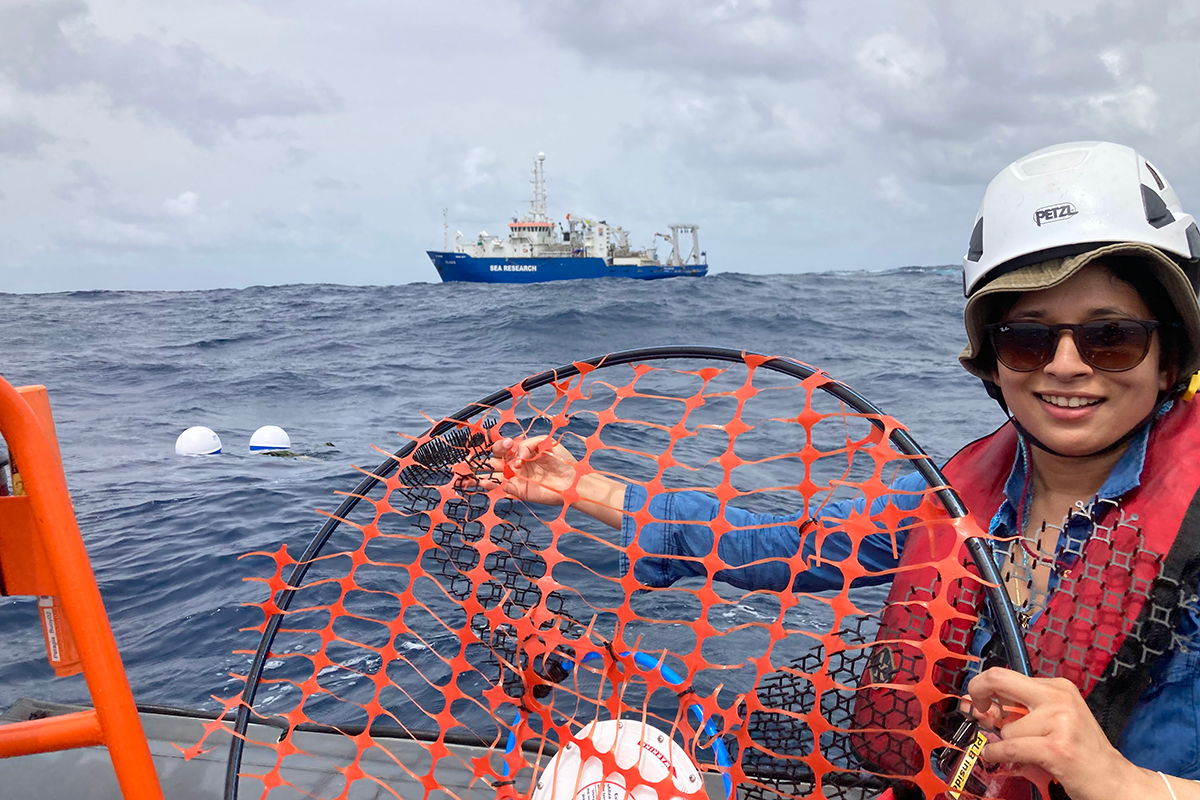
26 June 2024
The Great Atlantic Sargassum Puzzle: A Significant Piece
"I believe that the Sargassum blooms that have occurred in the North Tropical Atlantic since 2011 are one of the decade's most significant challenges. This is evident since we do not completely understand the phenomenon. Why is the Sargassum growing so rapidly? What are the key factors that have caused these blooms? Is climate change the only driving factor? With so many intriguing questions, different disciplines must collaborate.
Let me begin by stating that we can't understand what we do not know. This is likewise true of Sargassum. We knew it was in the Sargasso Sea. However, in 2011, the news and scientific literature began to spread, informing us that there were huge quantities of these algae on the beaches of several countries. This indicated that we were in trouble, and the economy, environment and health of these countries and the people living near these coasts were compromised. So, to provide a reasonable explanation, we must first comprehend the biology and physiology of Sargassum. But how? By growing and exposing it to various environments.
With the support of Dr. Brigitta van Tussenbroek’s laboratory (UASA, UNAM), we created a system for growing and maintaining Sargassum. This technique has been successful in keeping Sargassum under a variety of environmental conditions. Now aboard the R/V Pelagia – our beautiful research vessel – and with the help of a great scientific community on board, we’re attempting to learn more about the impact of upwelling water, Saharan dust, and other nutrients on recurring Sargassum blooms in a simplified version of the system that we have developed, you can see it in the photo. We combine these three because the upwelling water is derived from 500 meters depth, the Saharan dust contain contains diverse nutrients and micronutrients, and the Amazonian waters are nutrient-rich. Very interesting, isn't it?
For me, this approach represents a big opportunity to integrate several factors that could be driving this phenomenon. We need to remember that these recurring blooms are part of several synergistic factors. So, I believe that our research represents a crucial piece of this large jigsaw puzzle."
Written by: Edén Magaña, Universidad Nacional Autónoma de México
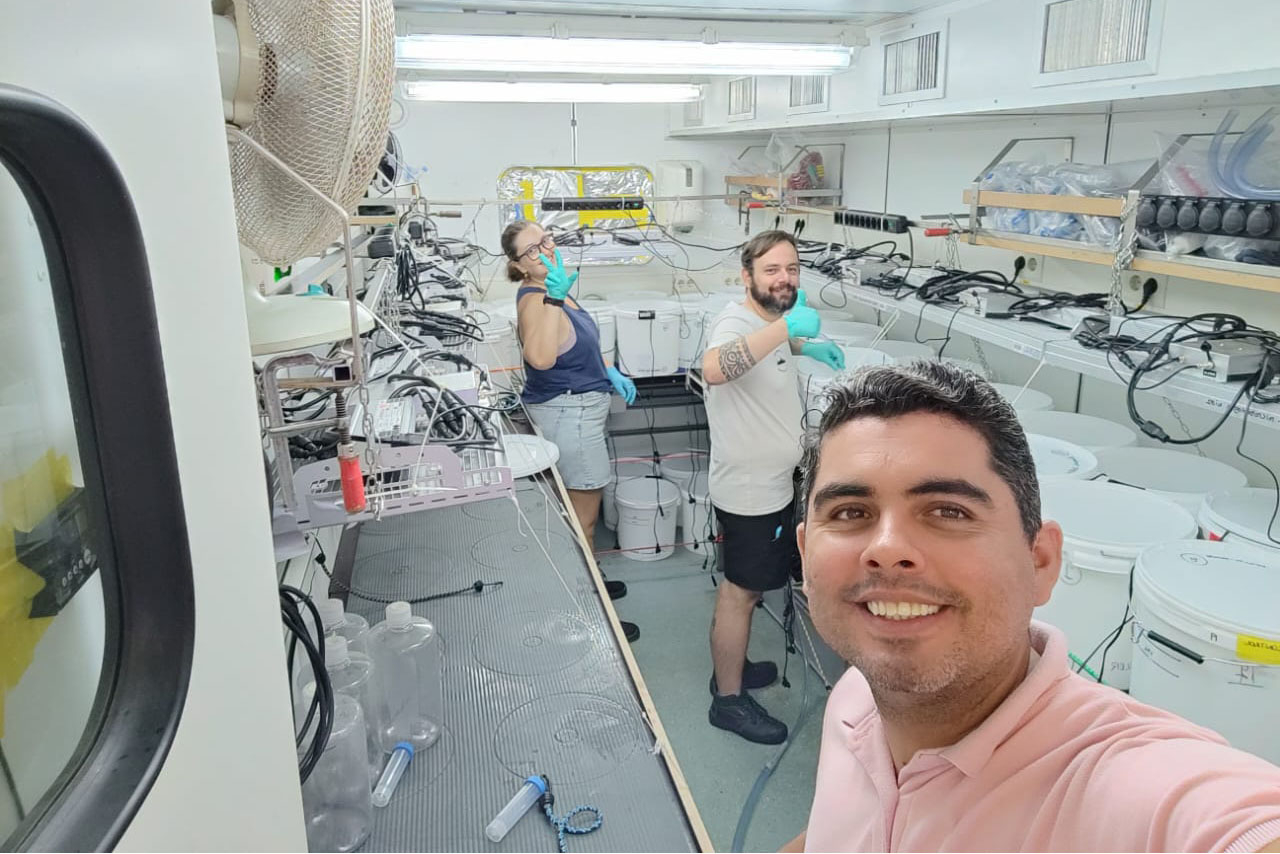
22 June 2024
Sargassum from space
Hi I’m Sully. I’m on board the ‘Weeds of Change’ cruise as a scientist from Professor Chuanmin Hu’s Optical Oceanography Laboratory (OOL) at the University of South Florida. I just completed my Master's in Marine Science, where I used high-resolution satellite imagery to track the movement of Sargassum and study its impact on local water temperatures. Sargassum can be identified from space by its unique color, which helps us understand how much of it is in the ocean, how its concentration and location change, and when coastal communities might expect it to wash ashore.
blog continues below the image
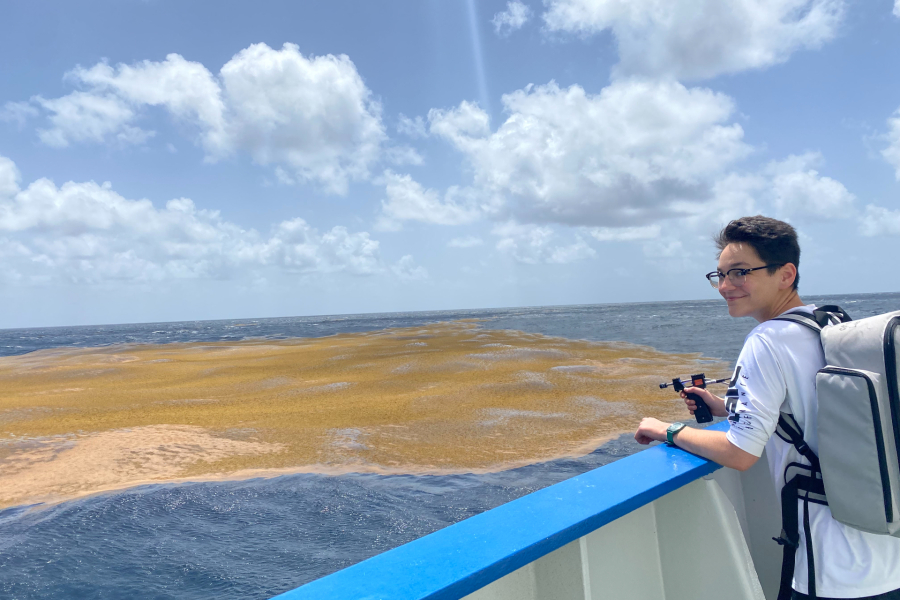
Onboard, I have several scientific responsibilities. I use satellite images processed with the Alternative Floating Algae Index (AFAI) to detect Sargassum mats and guide our ship's route. You can find these images on the OOL website as daily AFAI images or weekly Sargassum density images. These maps guide our expedition to the densest Sargassum patches for sampling and experimentation.
I take the reflectance spectra of Sargassum mats using a special device that looks like a "ghost buster’s" backpack. These measurements from various regions and types of Sargassum will help us improve our satellite detection algorithms for more accurate tracking. I dry Sargassum samples for Carbon-13 analysis which will help us understand which nutrients are fueling these blooms. Over the next three weeks I’ll be investigating how much light the Sargassum mats absorb and the temperature differences between the mats and the surrounding water. Understanding these factors can provide insights into the broader ecological impacts of Sargassum blooms.
Our science team is incredibly collaborative, always helping each other with different sampling efforts. We're currently approaching Station 9, where we'll start our second growth experiment. Here's hoping for calm seas and large Sargassum mats!
Written by: Sully Sullivan, MSc USF OOL
20 June 2024 - 10°51.360’N 053°26.820’W
Measuring metals in sargassum
Today we reached our sixth station. Cameras have explored Sargassum on the seabed and Surface Velocity Program drifters (SVPs) have been released to track Sargassum movements. Impressive Sargassum beds and their associated biodiversity have been observed. This also marks the end of the first round of Sargassum growth experiments.
Studying the growth of Sargassum gives us a better understanding of this phenomenon of large-scale proliferation. The studies are also intended to help governments make decisions about the governance of the recovery of this resource.
Previous research has shown that Sargassum is contaminated with metals such as arsenic (As) and iron (Fe). The toxicity of As depends on its oxidation state but also whether it is present in its organic or inorganic chemical forms. In general, trivalent arsenic compounds are more toxic than pentavalent forms. It is therefore essential to understand the accumulation of metals in these macroalgae so that their reuse does not endanger the health of users.
To do this, we have set up a protocol for growing Sargassum in a laboratory in Guadeloupe. We contaminate them with metals and initially look at the effect on their growth. Hypotheses were put forward to the effect that some metals can boost growth while others inhibit it. The algae were then analysed at the Arcachon Marine Station, in France to determine their accumulation capacity. Arsenic speciation is carried out to detect the arsenic form(s). During this scientific mission on the RV Pelagia, we are reproducing the same protocol to check whether there is an effect of water masses and Sargassum found in the open ocean. Contamination in the water is being monitored using passive diffusion sensors, known as DGTs, to gain a better understanding of potential iron and arsenic contamination in the water along this Atlantic transect. In addition, samples of Sargassum are being collected using manta trawls to check whether there is a gradient in the concentration of metals in Sargassum from Guadeloupe to Cape Verde.
So let's hope we find enough Sargassum along the way to learn more about them!
Written by: Marine Guilbaud
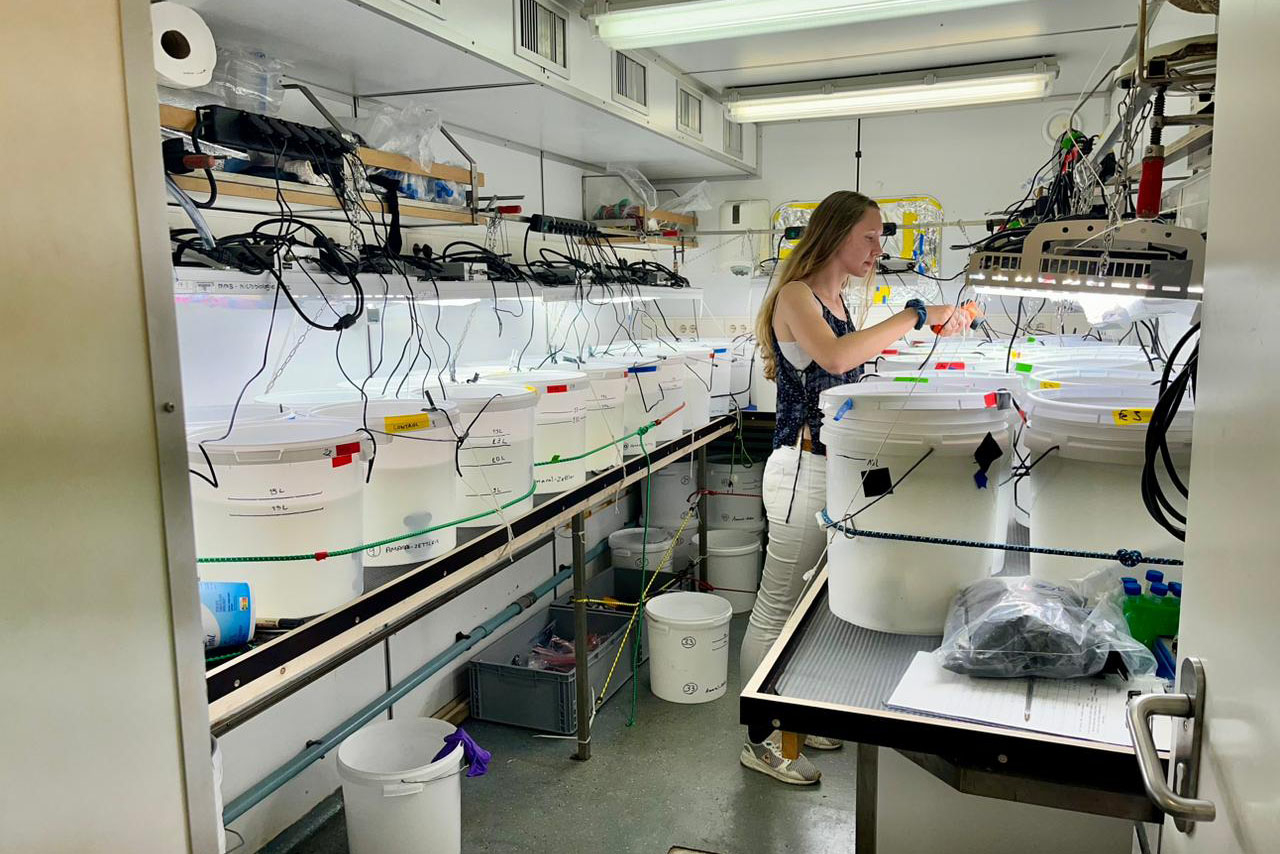
18 June 2024 - 14˚ 53.778’ N, 055˚ 47.238 W
Winds of Change
In fact, exactly 1000 kilometers north of Paramaribo in Suriname, the 64PE535 expedition is underway for more than 5 days from sunny Pointe-á-Pitre, Guadeloupe, to Mindelo, located on Sao Vincente (Cape Verde). The aim of the 'Weeds of Change' expedition is to obtain more information about the macroalga Sargassum. I help out where I can with the 11 other researchers, but I also have my MSc research with NIOZ Prof. dr Jan-Berend Stuut’s research program: Saharan Desert Dust.
The initial documentation on aeolian dust in the open ocean was by Moroccan explorer Edrisi (1100-1165/1166), with Charles Darwin publishing on it six centuries later. Dust's role in environmental change has been increasingly studied, highlighting its significant impact on the Earth's climate system, referred to as the 'Dust Cycle', which interacts with the hydrological and carbon cycles.
Saharan dust, driven by the Harmattan wind and trade winds, is transported upwards in convective cells and dispersed by atmospheric storms and turbulence. Understanding Saharan dust is crucial for insights into desertification, ocean life, and climate change. It carries nutrients to the ocean, affecting phytoplankton growth and ocean water composition, and influences rain, cloud formation, and albedo. Research on Saharan dust behavior in June and July will improve our understanding of this important dust stream.
That all sounds interesting at first, but then the question arises: How is the Saharan sand collected from the atmosphere? This isn’t possible with ordinary home garden and kitchen equip... well, it actually happens that way. In the air, dust floats among all other substances, which makes our atmosphere the atmosphere. The dust particles, aerosols, are generally slightly larger than the rest of the substances in the atmosphere. With a microfilter it is possible to filter these ultra-small particles from the air. On top of the highest deck of the ship “the monkey deck” there are two large blue birdhouses (one for organic aerosols (e.g. pollen) and one for inorganic aerosols (dust). The birdhouse contains a vacuum cleaner motor, just like you have at home. This vacuum cleaner sucks the air from outside through the filter and voilà, the dust is removed from the air. These filters are further processed at the NIOZ on Texel. Here we look at, among other things, the amount of the dust (mass), composition of the dust (composition) and the grain size/rounding.
So let’s hope for a lot of wind!
Sam van Duivenvoorde, MSc student NIOZ
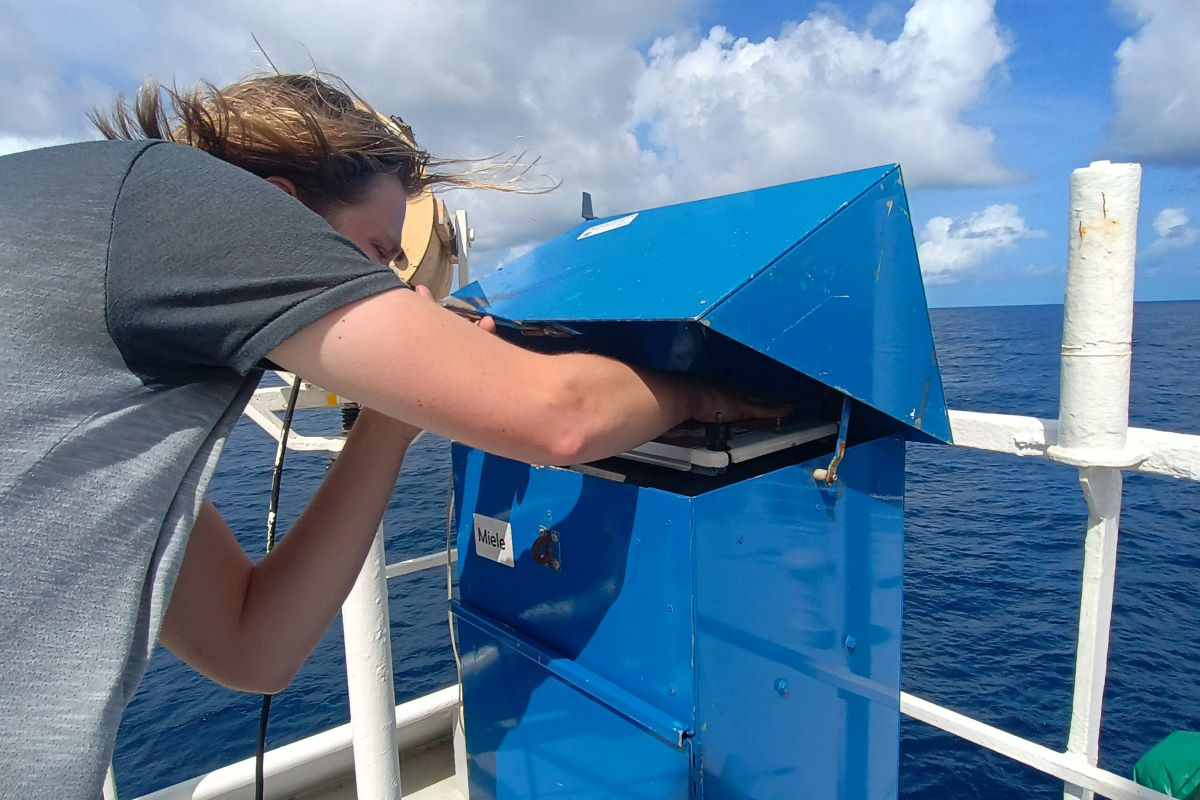
13 June 2024 - departure day
Our floating laboratory
Written by Linda Amaral-Zettler, expedition leader
The RV Pelagia’s “Weeds of Change” research expedition left the port of Pointe-à-Pitre, Guadeloupe France, on the 13th of June 2024, on her second voyage dedicated to the investigation of the so called “Great Atlantic Sargassum Belt” or GASB since 2019. The GASB is a large expanse of the tropical Atlantic that is now home to the World’s largest algal bloom of a type of brown seaweed called Sargassum. This expedition will bring together a group of international scientists funded through the Dutch Science Foundation, the French Science Foundation, and the Brazilian Science Foundation alongside visiting scientists from Mexico, Germany, and the United States to study aspects of the causes and fate of this massive algal bloom from the physical, chemical, geological and biological dimensions. For the next four weeks, the ship will be our “floating laboratory” where we will study both the horizontal and vertical movements of Sargassum, perform growth experiments on shipboard to better understand the influence of nutrients, metals, dust inputs from the Saharan Desert and Amazon Plume waters, and explore the past and present biodiversity of the Sargassum ecosystem using a combination of lipid and DNA characterizations. So, join us aboard our high-seas exploration of this poorly studied but vibrant floating oasis in the vast open waters of the Atlantic Ocean to better understand this unprecedented phenomenon.
